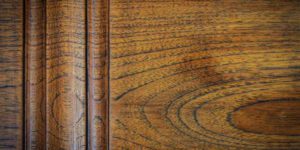Patina on wood is a surface layer that develops over time, resulting in a muted grayish hue with the natural color of the wood beneath it. It occurs when untreated wood is exposed to the elements, allowing the wood grain and patterns to become more apparent.
This natural aging process is similar to the development of patina on precious metals. As hardwoods are exposed to UV light and oxygen, their color will change over time, with lighter woods becoming darker and richer, while darker woods will lighten up.
The beauty of wood patina lies in its authenticity and the unique character it adds to furniture and other wooden items.
Understanding Patina
Patina is a natural coating that forms on various surfaces over time. It is particularly sought after in the world of antique furniture and woodwork. Patina adds character and charm to the wood, giving it a unique and aged appearance.
Patina on wood develops through a combination of factors. When wood is exposed to the elements, such as sunlight, air, and moisture, it undergoes a gradual oxidation process. This oxidation leads to changes in the wood’s color and surface texture, resulting in the formation of patina.
Over time, the original color of the wood becomes muted, as a grayish hue develops on the surface. The natural grain and patterns of the wood also become more pronounced, adding depth and character to the piece.
The appearance of patina on wood can vary depending on the type of wood and the conditions it is exposed to. Generally, patina gives wood a warm and inviting look, reminiscent of aged treasure.
Authentic wood patina will have a muted grayish hue on the surface, with the original wood color subtly peeking through. This natural patina gives wood a unique character, showcasing its history and story.
Patina on wood can also be intentionally applied to enhance its beauty. Techniques such as using aging solutions, wax, or paint can create an artificial patina that mimics the natural aging process. This allows craftsmen to achieve the desired aesthetics and vintage appeal.
| Benefits of Patina on Wood |
|---|
| Enhances the natural beauty and richness of wood |
| Adds depth, texture, and character to furniture and woodwork |
| Gives a sense of history and authenticity to pieces |
| Brings warmth and charm to any space |
To maintain and enhance the beauty of patina on wood, regular cleaning and maintenance are essential. It’s important to use gentle cleaning methods and natural wood care products to prevent damage or alteration of the patina.
In conclusion, patina on wood is a natural and beautiful phenomenon that adds character and depth to furniture and woodwork. Whether it develops organically over time or is intentionally applied, patina gives wood a timeless appeal and a sense of history.
Natural Wood Patina
A natural wood patina is a unique transformation that occurs on the surface of wood over time, creating a beautiful and aged appearance that adds character and depth to the material.
Muted Grayish Hue
One defining characteristic of natural wood patina is its muted grayish hue, which softens the original color of the wood while enhancing its overall charm. This subtle change in color gives the wood a weathered look.
Revealed Wood Grain And Patterns
As the wood patina develops, it brings out the natural grain and intricate patterns of the wood, adding a touch of elegance and authenticity to the piece. The rich color variations and textures become more pronounced with time.
Causes Of Wood Patina
Exposure to UV light and oxygen are primary contributors to the formation of patina on wood. The ultraviolet rays from sunlight accelerate the oxidation process, causing wood to weather and develop a silvery-gray hue over time.
Wood undergoes color changes naturally as it gets exposed to UV light and oxygen. Lighter woods tend to darken and enhance their richness, while darker woods lighten up due to the aging process.
Creating Patina On Wood
Want to give your wood furniture or decor a unique and charming look? Creating a patina on wood can add character and depth to any piece. Whether you prefer an artificial development or encouraging a natural formation, there are various methods you can try. Let’s explore both options:
Artificial Development
If you’re looking for a quick and controlled way to develop patina on wood, artificial methods can be a great choice. These techniques allow you to achieve the desired look without waiting for years of natural aging. Here are a few methods to consider:
- Dry Brushing: Use a dry brush to apply paint in a sporadic and random fashion all over the wood’s surface. This technique gives the wood a weathered and aged appearance.
- Antiquing Wax: Apply a layer of antiquing wax to the wood after painting or staining. This will create a subtle vintage effect and enhance the patina.
- Patina Paints: Look for specialized paints that are specifically designed to create a patina effect. These paints often contain metallic particles, which create an aged and weathered look when applied to the wood.
- Gilding Wax: Use gilding wax in various shades to highlight specific details and add depth to the wood. This technique works particularly well on carved or ornate surfaces.
Encouraging Natural Formation
If you prefer the authenticity and uniqueness of naturally formed patina, you can encourage the process by exposing the wood to the elements and allowing it to age over time. Here are some tips for encouraging natural patina:
- Exposure to UV Light: Position your wood furniture or decor near a well-lit window or in an outdoor area where it will be exposed to sunlight. Over time, UV light will cause the wood to naturally darken and develop a patina.
- Oxygen Exposure: Allow air circulation around the wood to help accelerate the aging process. This can be achieved by keeping the wood in a well-ventilated room or by placing it in an outdoor area.
Remember, patina on wood is a gradual process, and it may take several years for a noticeable change to occur. However, the end result will be a beautiful and unique piece with a natural, time-worn appearance.
Preserving Patina
Wood patina refers to a natural, aged appearance that develops on wood over time. It showcases a subtle, grayish hue with hints of the original wood color peeking through, revealing the beauty of the material’s natural grain and texture. Wood patina evolves through exposure to the elements, creating a unique and timeless finish.
Conserving The Aged Look
Preserving the patina on wood is essential to maintain its vintage charm and character over time.
Conserving the aged look requires proper care and maintenance of the wood to prevent deterioration and loss of patina. Here’s how to ensure the aged look stays intact:
- Regularly clean the wood with a gentle cleanser to remove dust and dirt without disturbing the patina.
- Avoid using harsh chemicals or abrasive cleaners that can strip away the natural patina.
- Apply a protective wax or sealant to shield the wood from environmental factors while preserving its aged appearance.
Maintaining Original Beauty
To maintain the original beauty of wood patina, it’s crucial to adopt proper preservation techniques. Here are some tips for maintaining the original beauty:
- Keep the wood away from direct sunlight to prevent fading and discoloration of the patina.
- Control the humidity levels in the environment to prevent warping or cracking of the wood.
- Regularly inspect the wood for any signs of damage or wear, and address them promptly to prevent further deterioration.
Patina In Various Materials
Patina on wood shares similarities with patina on precious metals. Both develop a rich, nuanced appearance over time, adding character and depth to the material.
The patina on wood can be influenced by various chemical processes such as oxidation and exposure to environmental elements. These processes gradually alter the surface of the wood, resulting in a unique patina.

Frequently Asked Questions For What Is Patina On Wood
What Does Patina Look Like On Wood?
A natural wood patina on furniture appears as a muted grayish hue on the surface, revealing the original color just underneath. It develops over time, enhancing the natural grain and patterns of the wood. Wood patina is similar to the development of patina on precious metals.
What Does Patina Mean On Wood?
Patina on wood refers to the natural aging and change in color that occurs over time. It results in a rich, deep color and enhances the natural grain and patterns of the wood. Hardwoods will develop a muted grayish hue with the original color lying just under the surface.
What Causes Wood To Patina?
Exposure to UV light and oxygen causes wood to develop a natural patina, leading to a muted grayish tone and revealing the wood’s original color just beneath the surface. All hardwoods undergo this aging process, with lighter woods becoming richer and darker over time, while darker woods lighten.
How Do You Make Patina On Wood?
To create patina on wood, dry brush in random strokes, add antiquing wax, and repeat the process on all surfaces.
Conclusion
Wood patina takes a similar course of development as precious metals, and it adds a unique charm and character to wooden furniture. The natural aging process and exposure to elements create a beautiful muted grayish hue on the surface, revealing the original color of the wood underneath.
This authentic and applied patina showcases the natural grain and patterns of the wood, making it more apparent and visually appealing. So, embrace the beauty of patina on wood as it showcases the history and adds depth to your furniture.


